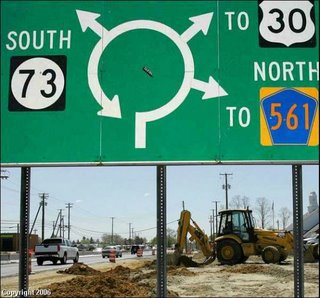*
Courier News Online - Circle vs. roundabout: The debate spins on
Circle vs. roundabout: The debate spins on
Saturday, May 6, 2006
By BETH DeFALCO
The Associated Press
TRENTON -- Like jug handles, hometown parkway exits and having your gas pumped, traffic circles are a notorious part of New Jersey life. So, a plan to eliminate four of the state's 35 circles, including on Route 202 in Flemington, this year might come as welcome news to drivers who find traffic circles annoying, confusing and dangerous.
But proposals to convert circles into "roundabouts" -- a European traffic favorite -- might have drivers wondering if a circle by another name will be annoying just the same. The state hopes to eventually eliminate all of its circles, a process that could take many years.
Tammy Johnson, 37, of Hamilton said she disdains traffic circles.
"They're a nightmare," said Johnson, who often travels through Whitehorse Circle in Hamilton -- one of the Trenton suburb's most intricate circles -- to bring her daughter to day care. "I avoid them as much as possible."
But she also wonders, "What's a roundabout?"
Johnson and other New Jersey drivers will soon come across more roundabouts as the state, following a national trend, begins building the circular intersections, which studies show are safer than traffic circles or traffic lights.
Commonly found throughout Europe, roundabouts were perhaps first made famous in the United States in the 1985 movie "National Lampoon's European Vacation." Chevy Chase's character gets stuck in a London roundabout, driving his family around in circles for hours, reciting: "Look kids -- Big Ben, Parliament. Look kids -- Big Ben, Parliament."
While they share the same-shaped nucleus, traffic circles and roundabouts are distinctly different.
Both have circular medians, but roundabouts are generally smaller (100-200 feet in diameter) and have more narrow lanes, forcing traffic to slow to maneuver turns. Traffic always enters directly facing the center, requiring vehicles to yield to traffic already moving inside.
Traffic circles have a larger nucleus (400-600 feet), have wider turns and are more of a free-for-all when it comes to yielding because people can enter at an angle and at different speeds.
Traffic engineers say roundabouts are attractive because they control entry into the circle, "calming" traffic by forcing everyone to travel at similar speeds. And unlike traffic signals, roundabouts keep cars moving, which has the added benefit of improving air quality.
Roundabouts also improve safety, according to industry research. A study by the Insurance Institute for Highway Safety found a 39 percent reduction in all crashes, a 79 percent reduction of injury-producing crashes and a 90 percent reduction in fatal accidents associated with roundabouts compared to traditional intersections.
"You can't ignore the numbers," said Howard McCulloch, a roundabout design specialist for New York state.
In New York, roundabouts are the default design for intersections, he said. The New York Department of Transportation requires that before the state can install a new traffic light at an intersection, a study on the feasibility of a roundabout must be performed.
Roundabouts also are seen as more cost-efficient than circles. New Jersey will spend $38 million to turn one circle into a traffic-signaled intersection and $50 million to build an overpass at another circle, but it will spend only $2.5 million to transform a third traffic circle into a roundabout.
"If there are improvements we can make that increase safety in a cost efficient manner and still move traffic," said New Jersey Transportation Commissioner Kris Kolluri. "We think we've got a win-win-win situation."
Still, traffic circles in New Jersey are a focal point of driver frustration.
"It's not a circle, it's a maze," said 18-year-old Pam Salamone. "A lot of people just don't know how to go through it, so it gets kind of crazy."

(Photo, Courier News)
Circles vs. roundabouts
TRAFFIC CIRCLES:
- Have circular medians
- Have a wider turning radius, allowing vehicles to travel faster
- Are usually 400-600 feet in diameter
- Vehicles can enter at an angle and at different speeds
- Have circular medians
- Have a more narrow turning radius, forcing vehicles to slow down to 12-15 mph
- Are usually 100-200 feet in diameter
- Traffic always enters directly facing the circle
- Vehicles entering always yield to traffic already moving inside
http://www.c-n.com/apps/pbcs.dll/article?AID=/20060506/NEWS03/605060311/1007
(In accordance with Title 17 U.S.C. Section 107, this material is distributed without profit to those who have expressed a prior interest in receiving the included information for research and educational purposes. Plainfield Today, Plainfield Stuff and Clippings have no affiliation whatsoever with the originator of these articles nor are Plainfield Today, Plainfield Stuff or Clippings endorsed or sponsored by the originator.)